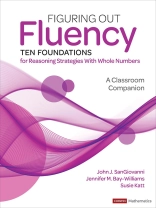Because fluency practice is not a worksheet.
Fluency in mathematics is more than basic facts or using algorithms. It is not about recall or speed. Real fluency is about choosing strategies that are efficient, flexible, lead to accurate solutions, and are appropriate for the given situation. Developing fluency is a matter of equity and access for all learners.
The landmark book Figuring Out Fluency in Mathematics Teaching and Learning offered educators the inspiration to develop a deeper understanding of procedural fluency. It explained the seven Significant Strategies for fluency and offered a plethora of pragmatic tools for shifting classrooms toward a greater fluency approach. However, in order to become truly adept with these strategies, children must first have certain underlying foundational concepts and skills in place.
Figuring Out Fluency-Ten Underlying Foundations for Reasoning Strategies with Whole Numbers explores the ideas that are essential to reasoning: Number Relationships; Subitizing and Decomposing; Distance to 10, 100, and 1, 000; Counting and Skip-Counting; Properties of Addition and Its Inverse Relationship with Subtraction; Properties of Multiplication and Its Inverse Relationship with Division; Multiplying by 10s and 100s; Multiples and Factors; Doubling and Halving; and Computational Estimation. With this book, elementary teachers can
- Help children develop these foundational understandings, critical to reasoning and number sense.
- Leverage over 100 classroom-ready routines, centers, and games to develop these concepts both in first instruction, practice, and intervention.
- Download all of the needed support tools, game boards, and other resources from the companion website for immediate implementation
Develop each and every students’ knowledge and power to become skilled and confident mathematical thinkers and doers.
Inhoudsopgave
Part I: Figuring out Fluency Foundations: Big Ideas
Part 2: Foundations Modules
Module 1: Number Relationships: Comparison and Estimation
Module 2: Subitizing to Decomposing
Module 3: Distance to 10, 100, and 1, 000
Module 4: Counting and Skip-Counting
Module 5: Properties of Addition and Its Inverse Relationship with Subtraction
Module 6: Properties of Multiplication and the Inverse Relationship with Division
Module 7: Multiplying by 10s and 100s
Module 8: Multiples and Factors
Module 9: Doubling and Halving
Module 10: Computational Estimation
Part 3: Taking Action
Appendix A: Activity List
References
Over de auteur
Susie Katt is the K-2 Mathematics Coordinator in Lincoln, Nebraska, where she leads professional learning, assessment, and math curriculum development. She is an author of Productive Math Struggle: A 6-Point Action Plan for Fostering Perseverance and Answers to Your Biggest Questions About Teaching Elementary Math. She is also a national math curriculum consultant. Susie speaks at state, regional, and national conferences. She served the National Council of Teachers of Mathematics (NCTM) as the chair of the editorial panel for the journal Teaching Children Mathematics, as department editor for Mathematics Teacher: Learning and Teaching PK–12, and as a member of program committees for annual meetings and regional conferences. Susie was recently elected to the board of directors for the National Council of Supervisors of Mathematics (NCSM) as Regional Director, Central 2.












